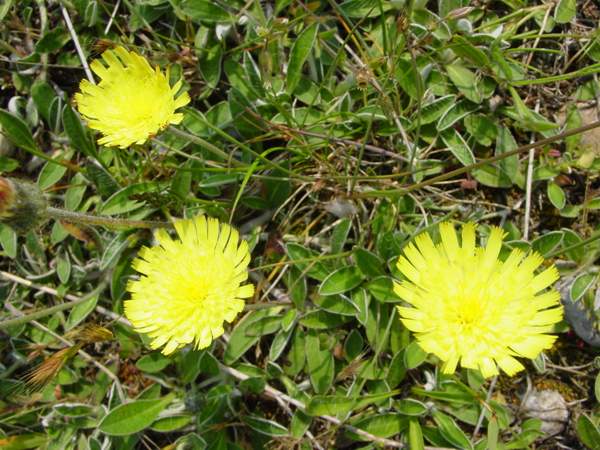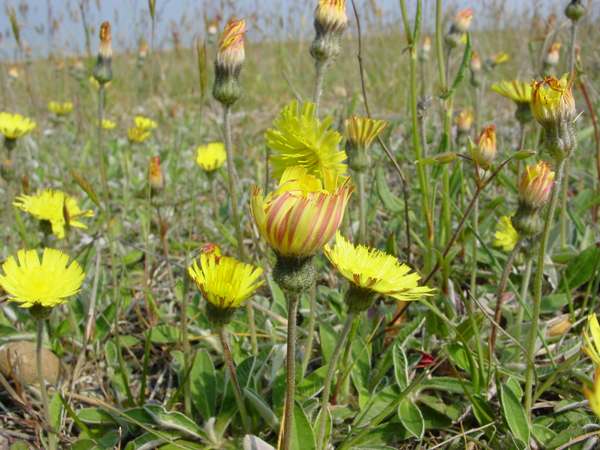Trees Birds Mammals Fish Amphibians Reptiles
Wild Algarve
Bookshop
Pilosella officinarum - Mouse-ear Hawkweed
Phylum: Magnoliophyta - Class: Equisetopsida - Order: Asterales - Family: Asteraceae

We see bright yellow roadside banks with thousands of hawkweed flowers waving in the summer breeze or swirling in the slipstream created by passing vehicles. Rarely can we say at a glance with any confidence which species they are - indeed, many people simply (and quite wrongly) assume that they are all dandelions!
Description
There are very many species of hawkweeds, and Pilosella officinarum is a complex of many species with numerous subspecies, varieties and forms.

Above: Mouse-ear Hawkweed, gets its name from the hairy oval leaves at the base of the plant.
Separating the various yellow hawkweed species requires specialist knowledge and much patience.

Mouse-ear Hawkweed is a hairy perennial perennial plant, with a distinctive basal rosette of oval untoothed leaves whose undersides are covered in dense whitish glandular hairs. The leafless stem, typically up to 25cm tall but occasionally reaching to 50cm, bears a single lemon yellow flower head 2 to 3cm in diameter whose outer rays ('petals' as some people losely term them) have red or orange-red undersides.

New plants form at the ends of runners, which then decay so that the parent plant is no longer attached to the clones that it has produced vegetatively. As with other hawkweeds, Mouse-ear Hawkweed also propagates by seeds.
Distribution
This lovely hawkweed is common and widespread throughout Britain and Ireland, and its native range extends through mainland Europe into parts of Asia..
Habitat
On dryish roadside verges and grassy banks, particularly the slopes of vegetated coastal sand dunes.

Flowering Times
In Britain and Ireland the flowers of Mouse-ear Hawkweed can be seen from May to October, but they are usually at their best in mid summer. The pictures shown on this page were taken between the end of May and late August.

Above: the seed heads of Mouse-ear Hawkweed
Looking rather like small dandelion heads, the seed heads of Mouse-ear Hawkweed contain many seeds, known as achenes, each of which is attached to a parachute-like pappus. As with dandelion clocks, the seeds are dispersed during windy weather.
Etymology
The genus name Pilosella means 'with small hairs' - a reference to the hairy leaves - while the specific epithet officinarum refers to a workshop and hence implies that this herb was used in the production of food or medicine.
Similar Species
Fox-and-cubs, an orange hawkweed, is also abundant in the UK, and can create a spectacular roadside display in high summer.
Sue Parker's latest ebook is a revised and enlarged edition of Wild Orchids in The Burren. Full details here...
Buy it for just £5.95 on Amazon...
Sue Parker's new ebook is a comprehensive and fully revised edition of her acclaimed field guide to the Wild Orchids of Wales. Full details here...
Buy it for just £5.95 on Amazon...
Please Help Us: If you have found this information interesting and useful, please consider helping to keep First Nature online by making a small donation towards the web hosting and internet costs.
Any donations over and above the essential running costs will help support the conservation work of Plantlife, the Rivers Trust and charitable botanic gardens - as do author royalties and publisher proceeds from books by Pat and Sue.